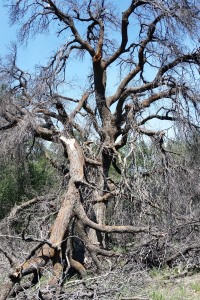Goldspotted oak borer (GSOB, Agrilus auroguttatus) is a flatheaded borer (Coleoptera: Buprestidae) whose larval stage feeds extensively in the phloem/wood of a variety of oak trees (Quercus spp.). It is native to the woodlands in southeastern Arizona but it is widely believed that GSOB was transported by means of firewood. In recent years, there have been several introduced beetles in southern California that affect multiple tree species. These invasive species have become such an issue that several working groups, including the Emerging Tree Pests Education & Outreach group, have been developed to help organize coordinated responses to these pests across agencies and jurisdictions. Polyphagous shot hole borer and Kuroshio shot hole borer (both Curculionidae: Scotylinae: Euwallacea sp.) feed voraciously on a variety of tree and shrub species. Polyphagous shot hole borer has been shown to attack over 200 host species alone and the invasion of Kuroshio shothole borer killed thousands of willows in Tijuana Estuary within about a year.
This study focuses on the invasive GSOB and its impact on oak woodlands in southern California. It has killed an estimated 80,000 coast live oaks (Quercus agrifolia) in San Diego County alone and now has new sites of infestation in Riverside, Orange, and Los Angeles counties. Management efforts have had little success. The coast live oak is a foundational species in California and has an expansive range from Oregon to Mexico. As a result, the loss or decline of the species could have large and far-reaching deleterious ecological impacts. As a foundational species, these oak woodlands have a diverse assemblage of organisms and provides many ecosystems services that are not found in other sympatric ecosystems. The oak species is long-lived but also has slow growth and low fecundity which has raised concerns about its resilience and long-term persistence.
It is important to understand whether GSOB drives demographic changes in the oaks, or whether it drives the oaks out of the system. This study is important as it will describe and document changes to multiple aspect of coast live oak woodlands, including understory plants and arthropods, as the infestation increases in extent and severity. These community-level impacts of GSOB on coast live oak woodlands will be quantified, describing multiple direct and indirect effects.
Research Objectives
1. Measure oak canopy condition and seedling recruitment to look at the potential long-term population impact of elevated adult oak mortality.
2. Evaluate the impacts of A. auroguttatus on Quercus agrifolia understory primary producers.
3. Evaluate the impact of altered woodland composition and understory structure on arthropod communities.
a. Evaluate direct and indirect effect of canopy loss and the associated changes in understory plants on arthropods number, diversity, and composition.
b. Compare and contrast changes in arthropods between ground associated and flying arthropods.
The main method that GSOB has been spread is via firewood, so please buy it where you burn it and check out these great resources on the beetle:



